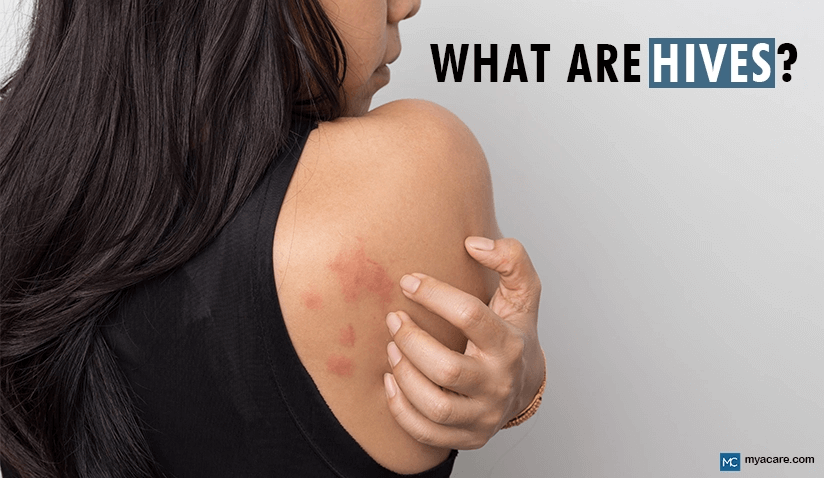What Is Urticaria (Hives)?

What is Urticaria?
Urticaria, also called hives, is a common skin condition causing raised, red, itchy bumps, welts, or wheals on the skin that appear and disappear quickly. It is mostly seen in children, adolescents, and young adults, but it can affect all age groups. Urticaria is generally benign and self-limited. Sometimes, it is accompanied by angioedema, which is the localized swelling or edema usually seen on the face, especially around the eyes or the lips.
What are the Kinds of Urticaria?
Urticaria is classified as either acute or chronic.
- Acute urticaria (AU) – occurrence of spontaneous wheals or angioedema for less than 6 weeks duration
- Chronic urticaria (CU) – occurrence of wheals or angioedema daily or almost daily for more than or equal to 6 weeks; can be subclassified into:
- Chronic Spontaneous Urticaria (CSU) – the cause is mainly idiopathic or unknown
- Chronic Inducible Urticaria (CIndU) – patients develop urticaria in response to a specific stimulus such as cold water, tight clothing, sweat, etc.
Under chronic inducible urticaria are other subtypes, such as:
- Cold urticaria – the appearance of wheals in response to cold
- Delayed pressure urticaria – wheals that appear in a continually compressed region; can be accompanied by a burning sensation or pain
- Heat urticaria - wheals that flare within minutes after local heat exposure to the skin and disappear within a few hours
- Solar urticaria – wheals that develop within minutes after local exposure to certain wavelengths of light
- Symptomatic dermographism – development of itchy wheals or burning skin sensations in areas exposed to shearing forces on the skin
- Vibratory angioedema – wheals that develop at the site of contact with vibratory stimuli such as jogging
- Aquagenic urticaria – wheals induced by local skin exposure to water
- Cholinergic urticaria – wheals induced by stimuli that cause sweating such as physical exercise, hot temperature environment, or heightened emotions
- Contact urticaria – immediate development of wheals on sites of contact with specific substances
What are the Causes of Urticaria?
Etiologies for acute urticaria include:
- Acute infections (viral, bacterial)
- Food allergies
- Allergies to drugs/medications
- Vaccines
- Bee stings, insect venom
- Parasitic infections
- Contact allergens, such as latex
Etiologies for chronic spontaneous urticaria include:
- Idiopathic cause (80-90% of cases)
- Chronic underlying infections
- Chronic autoimmune diseases
- Other aggravators of wheals in CSU: heat, tight clothing, drug allergies, viral infections, food pseudoallergies
Symptoms of Urticaria
Urticaria classically presents ase red, itchy hives or wheals that can appear on any part of the body. There may be large, swollen areas on the skin, specifically around the eyes or lips (angioedema) accompanying these lesions. The hives typically resolve within 24 hours and can reappear in a different distribution on the body. Angioedema, on the other hand, may take days to resolve.
Laboratory Tests for Urticaria
The diagnosis of urticaria is largely clinical. A thorough history and physical examination are enough to diagnose this skin disease and determine the possible triggers. For cases of chronic urticaria, routine diagnostic tests may include getting a complete blood count (CBC), C-reactive protein (CRP), and erythrocyte sedimentation rate (ESR). Liver enzymes and thyroid function tests may also be requested depending on the symptoms exhibited by the patient. A biopsy of an urticarial lesion is nonspecific and is not a requirement for diagnosis.
Treatment of Urticaria
The cornerstone of urticaria treatment is avoidance of triggers, especially if already identified. The primary treatment for both acute and chronic urticaria is the use of second-generation H1 antihistamines, such as loratadine, fexofenadine, cetirizine, desloratadine, and bilastine.
Other treatment modalities for urticaria and angioedema include the following:
- Other antihistamines (H2 antihistamines, Leukotriene modifiers) – to help control the itch and swelling
- Soothing anti-itch cream or lotion – to give temporary relief
- Systemic corticosteroids – for severe cases of urticaria
- Immunosuppressive agents
- Biologics (Omalizumab)
- Phototherapy
Practical Tips for Urticaria
- Avoid possible triggers.
- Keeping an urticaria diary can help you identify unknown triggers and possible causes.
- Treat identified chronic infections.
- Cool the affected area. You may use an ice pack, soothing moisturizer, or a fan.
- Reduce friction and avoid tight clothing.
- Dress according to the weather.
- Apply broad-spectrum sunscreens.
Take-Home Messages
Urticaria is a non-contagious skin condition that usually resolves in hours to days. However, it is often recurrent. Urticaria can negatively influence the quality of life of those affected by it; therefore, it is recommended to consult with your board-certified dermatologist in order to have the proper treatment and management for your urticaria.
To search for the best health providers for dermatology in Croatia, Germany, Greece, Italy, Malaysia, Singapore, Slovakia Spain, Thailand, The UAE, the UK, and the US, please use our free search engine.
To search for the best healthcare providers worldwide, please use the Mya Care search engine.
Dr. Lauren Livelo is a board-certified dermatologist from the Philippines. She has a degree in Medicine from the University of the East Ramon Magsaysay Memorial Medical Center, and has completed her dermatology residency training in the Research Institute for Tropical Medicine. Aside from her private practice, she enjoys writing about skin care and diseases of the skin.
References:
Featured Blogs



